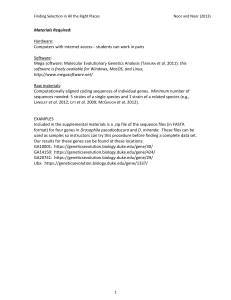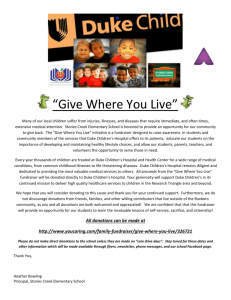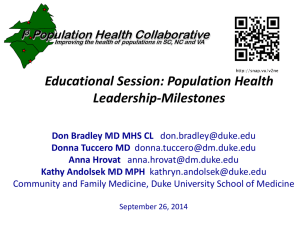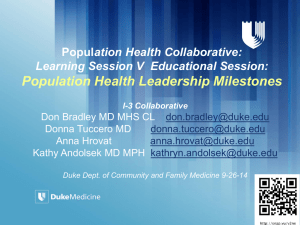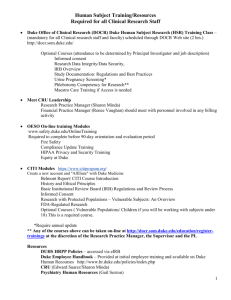Nicolas Lessios CV - Rutowski Lab
advertisement
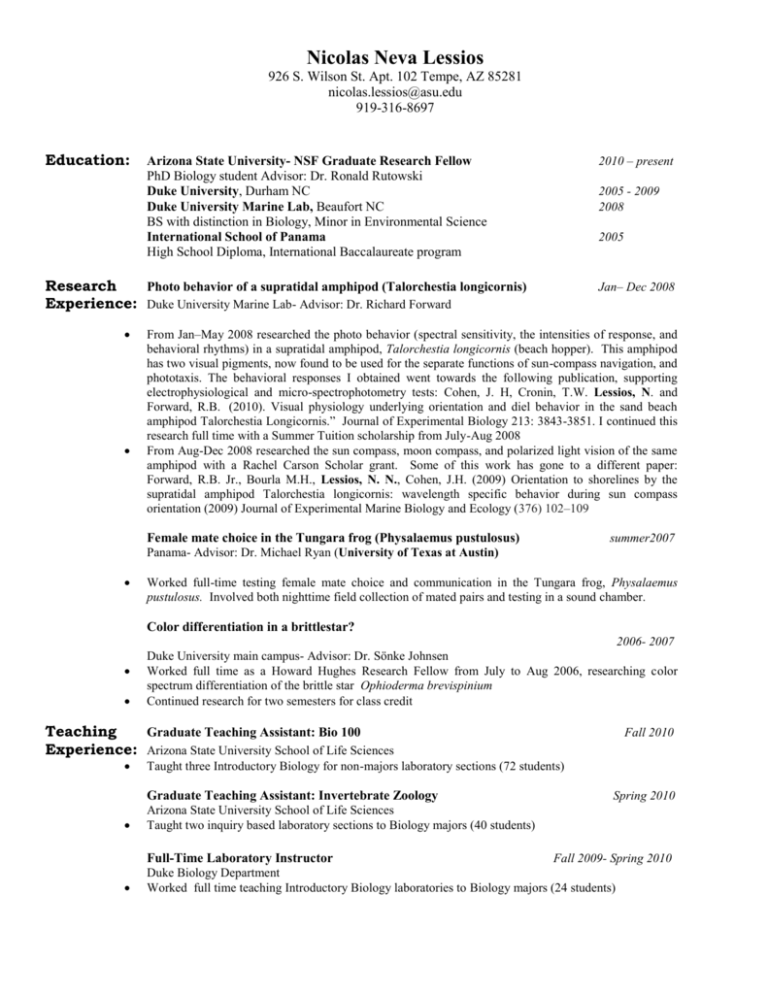
Nicolas Neva Lessios 926 S. Wilson St. Apt. 102 Tempe, AZ 85281 nicolas.lessios@asu.edu 919-316-8697 Education: Arizona State University- NSF Graduate Research Fellow PhD Biology student Advisor: Dr. Ronald Rutowski Duke University, Durham NC Duke University Marine Lab, Beaufort NC BS with distinction in Biology, Minor in Environmental Science International School of Panama High School Diploma, International Baccalaureate program Research Photo behavior of a supratidal amphipod (Talorchestia longicornis) Experience: Duke University Marine Lab- Advisor: Dr. Richard Forward 2010 – present 2005 - 2009 2008 2005 Jan– Dec 2008 From Jan–May 2008 researched the photo behavior (spectral sensitivity, the intensities of response, and behavioral rhythms) in a supratidal amphipod, Talorchestia longicornis (beach hopper). This amphipod has two visual pigments, now found to be used for the separate functions of sun-compass navigation, and phototaxis. The behavioral responses I obtained went towards the following publication, supporting electrophysiological and micro-spectrophotometry tests: Cohen, J. H, Cronin, T.W. Lessios, N. and Forward, R.B. (2010). Visual physiology underlying orientation and diel behavior in the sand beach amphipod Talorchestia Longicornis.” Journal of Experimental Biology 213: 3843-3851. I continued this research full time with a Summer Tuition scholarship from July-Aug 2008 From Aug-Dec 2008 researched the sun compass, moon compass, and polarized light vision of the same amphipod with a Rachel Carson Scholar grant. Some of this work has gone to a different paper: Forward, R.B. Jr., Bourla M.H., Lessios, N. N., Cohen, J.H. (2009) Orientation to shorelines by the supratidal amphipod Talorchestia longicornis: wavelength specific behavior during sun compass orientation (2009) Journal of Experimental Marine Biology and Ecology (376) 102–109 Female mate choice in the Tungara frog (Physalaemus pustulosus) summer2007 Panama- Advisor: Dr. Michael Ryan (University of Texas at Austin) Worked full-time testing female mate choice and communication in the Tungara frog, Physalaemus pustulosus. Involved both nighttime field collection of mated pairs and testing in a sound chamber. Color differentiation in a brittlestar? 2006- 2007 Duke University main campus- Advisor: Dr. Sönke Johnsen Worked full time as a Howard Hughes Research Fellow from July to Aug 2006, researching color spectrum differentiation of the brittle star Ophioderma brevispinium Continued research for two semesters for class credit Teaching Graduate Teaching Assistant: Bio 100 Experience: Arizona State University School of Life Sciences Taught three Introductory Biology for non-majors laboratory sections (72 students) Graduate Teaching Assistant: Invertebrate Zoology Spring 2010 Arizona State University School of Life Sciences Taught two inquiry based laboratory sections to Biology majors (40 students) Full-Time Laboratory Instructor Fall 2010 Fall 2009- Spring 2010 Duke Biology Department Worked full time teaching Introductory Biology laboratories to Biology majors (24 students) Publications: Forward, R.B. Jr., Bourla M.H., Lessios, N. N., Cohen, J.H. (2009). Orientation to shorelines by the supratidal amphipod Talorchestia longicornis: wavelength specific behavior during sun compass orientation. Journal of Experimental Marine Biology and Ecology 376: 102–109. Cohen, J. H, Cronin, T.W. Lessios, N. and Forward, R.B. (2010). Visual physiology underlying orientation and diel behavior in the sand beach amphipod Talorchestia Longicornis. Journal of Experimental Biology 213: 3843-3851. Wirth, CW. Lessios, N. N. Scheunemann, N. (Presented Jan. 2010). Challenges and the importance of sustainable hunting in Waorani Territory: bicultural ecology education (theory and investigation). Environmental, Cultural, Economic & Social Sustainability Conference 2010. W. Dickinson, J. Ferreyra, K. L. Imbesi, S. Joshi, C. Kingsolver, E. Klein, N. N. Lessios, A. Ng, T. Stamp, K. White, D. Xu and R. L. Vidra (2006). The Ethical Challenges Faced by Ecological Restorationists. Ecological Restoration Vol. 24, no. 2, pp. 102-104. Grants/ Honors: Service: National Science Foundation Graduate Research Fellowship (Arizona State, James B. Rast Department Award for Comparative Organismal Biology (Duke, 2005-2009) Graduation with Distinction in Biology (Duke 2009) Dean’s list (Duke 2008) Howard Hughes summer research program (Duke summer 2006) $3,300 Tungara Frog Research internship (Duke summer 2007) $3000 Duke Engage Grant (Duke summer 2008) $7,300 per person Summer Tuition scholarship (Duke summer 2008) $2,352 Rachel Carson Scholar grant (Duke 2008) $750 Jumpstart Research Grant (ASU Fall 2010) GPSA Travel Grant for Panama research course (ASU Fall 2010) Jumpstart Research Grant (ASU Spring 2010) GPSE (Graduate Partners in Science Education) $480 $600 $490 Spring 2011-present Mentored junior high students in traditionally underprivileged schools, meeting weekly to develop science fair projects in the spring, which we carried out together. Students then presented their projects at a regional Science Fair. Reforestation/Education Project Summer 2008 Boquerón, Panama Obtained funding and organized the community of Boquerón to reforest using native and lucrative species in farmland locked by the invasive wild cane, Saccharum spontaneum. (a town located in the Panama Canal watershed within Chágres national park) Applied for funding through the Duke Engage service program to bring myself and two other Duke students to the community. Bought 2,000 trees from a woman’s cooperative nursery in a neighboring town and arranged community involvement in both the transportation of the small trees, and the building of a temporary nursery. Both lucrative and native species were chosen by the village community to ensure their care after planting. Researched the monoculture cane extensively for the best methods to limit it. Also contacted scientists from the Smithsonian Tropical Research Institute and USAID officials in Panama for advice on methods for planting and for placement into the community with a host family. Contacted all the interested farmers from the community, arranging to clear the invasive cane, and to plant the trees with them. We also flagged the trees, stressing the importance of returning to take care of them. Followed up the planting to check on the trees with the farmers and fertilize them using aged chicken manure. Took GPS coordinates of each planting, creating a map and a summary, so that farmers would know the areas we had planted, and so that possible future projects could return and/or expand the areas planted, Pictures and summary can be found at: duke.edu/~nnl3 Service Research in Indigenous (Waorani) Communities Summer 2009 Amazonian Ecuador Facilitated and translated (to Spanish) for a group of 8 Duke Students traveling through 15 communities by canoe, trail and airplane. The overarching goal of the project was to interview the Waorani on how they perceived resource scarcity; we also installed eight sets of solar panels and built water-catchment systems. I interviewed Waorani hunters from different age groups about what animals they preferred and were encountering, with the aim of creating a map to better understand the current distribution of these game species so that they can manage them in the future. Skills/abilities: Native speaker proficiency in English and Spanish, Wilderness First Aid, SCUBA certified (NAUI) Hobbies: Backpacking, tree planting, gardening, spear fishing, canoeing, reading
